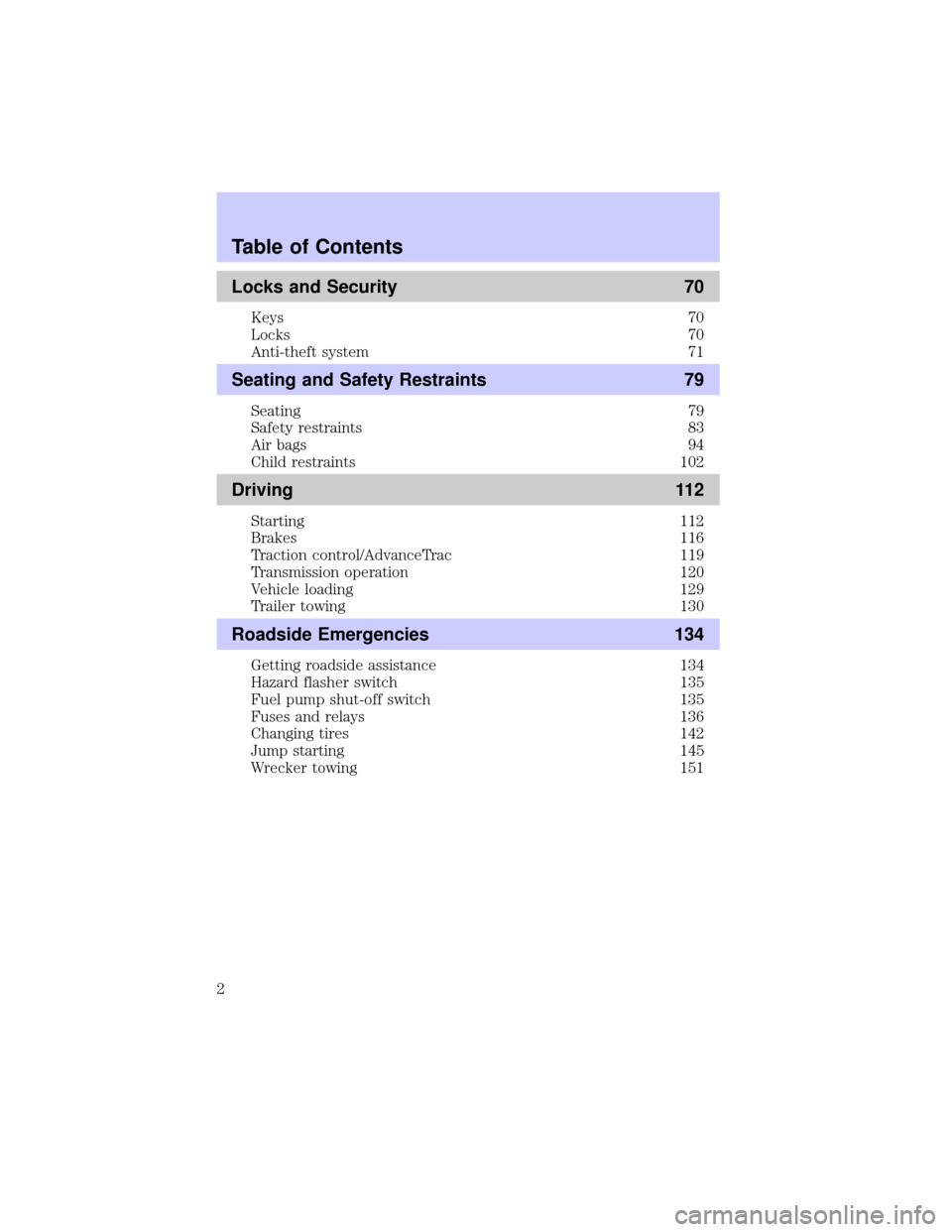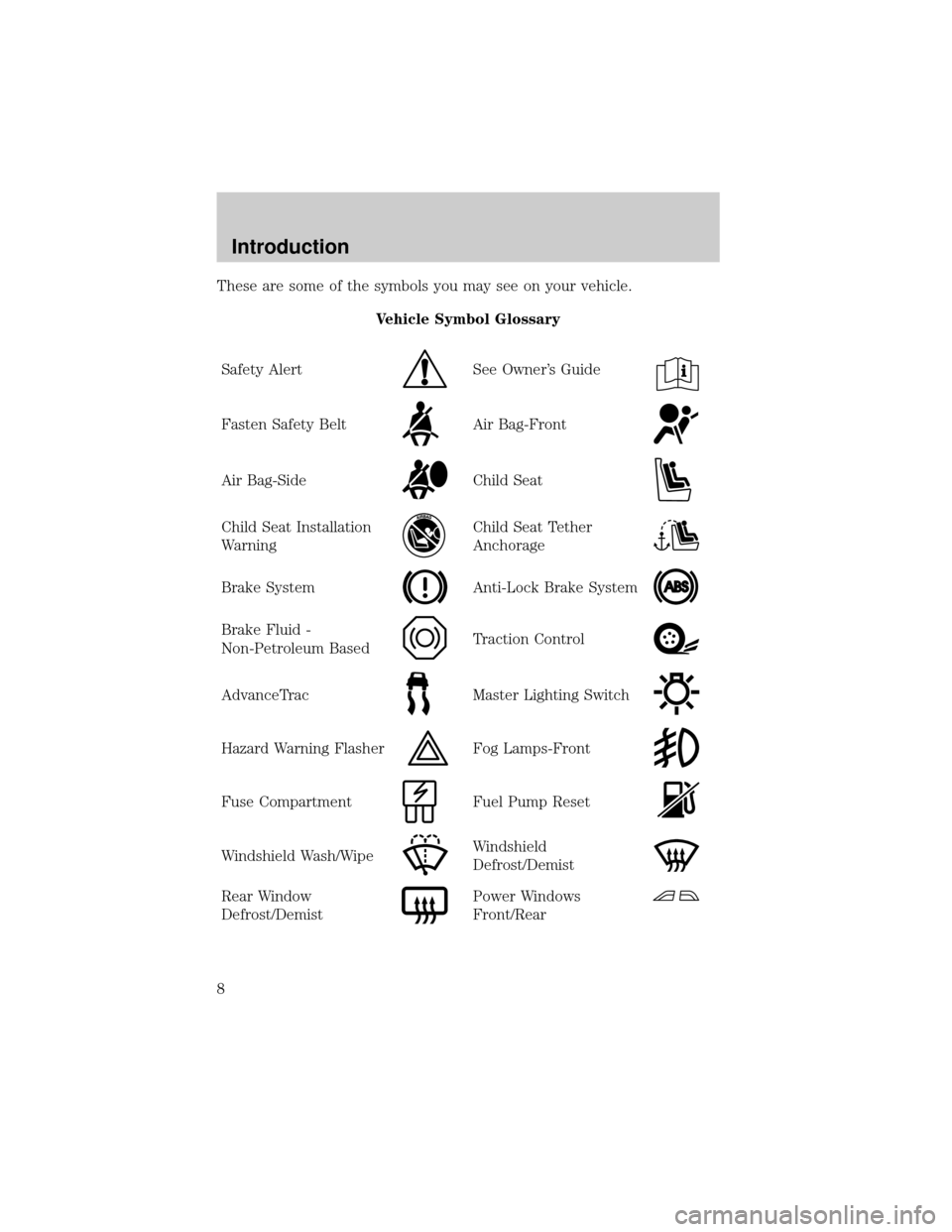traction control Mercury Mercury Cougar 2002 Owner's Manual
[x] Cancel search | Manufacturer: MERCURY, Model Year: 2002, Model line: Mercury Cougar, Model: Mercury Mercury Cougar 2002Pages: 216, PDF Size: 4.04 MB
Page 2 of 216

Locks and Security 70
Keys 70
Locks 70
Anti-theft system 71
Seating and Safety Restraints 79
Seating 79
Safety restraints 83
Air bags 94
Child restraints 102
Driving 112
Starting 112
Brakes 116
Traction control/AdvanceTrac 119
Transmission operation 120
Vehicle loading 129
Trailer towing 130
Roadside Emergencies 134
Getting roadside assistance 134
Hazard flasher switch 135
Fuel pump shut-off switch 135
Fuses and relays 136
Changing tires 142
Jump starting 145
Wrecker towing 151
Table of Contents
2
Page 8 of 216

These are some of the symbols you may see on your vehicle.
Vehicle Symbol Glossary
Safety Alert
See Owner's Guide
Fasten Safety BeltAir Bag-Front
Air Bag-SideChild Seat
Child Seat Installation
WarningChild Seat Tether
Anchorage
Brake SystemAnti-Lock Brake System
Brake Fluid -
Non-Petroleum BasedTraction Control
AdvanceTracMaster Lighting Switch
Hazard Warning FlasherFog Lamps-Front
Fuse CompartmentFuel Pump Reset
Windshield Wash/WipeWindshield
Defrost/Demist
Rear Window
Defrost/DemistPower Windows
Front/Rear
Introduction
8
Page 13 of 216

Traction ControlYactive
Illuminates when the Traction
Controlysystem is active. It will be
lit for a minimum of four seconds or
for the duration of the Traction
Controlyevent.
For more information, refer to theDrivingchapter.
Low fuel
Illuminates when the fuel level in
the fuel tank is at, or near, empty
(refer toFuel gaugein this chapter
for more information). When
refueling, after the light comes on,
the amount of fuel that is added will
be less than the advertised capacity
since there is fuel still in the tank.
O/D off (if equipped)
Illuminates when the overdrive
function has been turned OFF using
the Transmission Control Switch
(TCS) on end of gearshift. If the
light does not come on or the light
flashes steadily, have your vehicle serviced as soon as possible, as
damage to the transmission could occur.
Speed control (if equipped)
Illuminates when the speed control
is activated.
Turn signal
Illuminates when the turn signals or
the hazard lights are turned on. If
the lights stay on continuously or
flash faster, check for a burned-out bulb.
Instrument Cluster
13
Page 119 of 216

Always set the parking brake fully and make sure that the
gearshift is securely latched in P (Park) (automatic transaxle) or
in 1 (First) (manual transaxle).
Push the button on the end of the
parking brake and push the handle
down as far as possible to release
the brake. Driving with the parking
brake on will cause the brakes to
wear out quickly and reduce fuel
economy.
TRACTION CONTROLY
Your vehicle is equipped with a Traction Controlysystem. This system
helps you maintain the stability and steerability of your vehicle. It is
especially useful on slippery road surfaces. The system operates by
detecting and controlling wheel spin. The system borrows many of the
electronic and mechanical elements already present in the anti-lock
braking system (ABS).
Wheel-speed sensors allow excess rear wheel spin to be detected by the
Traction Controlyportion of the ABS computer. Any excessive wheel
spin is controlled by automatically applying and releasing the rear brakes
in conjunction with engine torque reductions. Engine torque reduction is
realized via the fully electronic spark and fuel injection systems. This
process is very sensitive to driving conditions and very fast acting. The
rear wheels ªsearchº for optimum traction several times a second and
adjustments are made accordingly.
The Traction Controlysystem will allow your vehicle to make better use
of available traction on slippery surfaces. The system is a driver aid
which makes your vehicle easier to handle primarily on snow, ice covered
and gravel roads.
During Traction Controlyoperation, the traction control active light will
illuminate, you may hear an electric motor type of sound coming from
the engine compartment and the engine will not ªrev-upº when you push
further on the accelerator. This is normal system behavior.
Driving
119
Page 120 of 216

The Traction Controlyon/off
switch, located in the center of the
instrument panel illuminates when
the system is OFF. The Traction
Controlysystem will revert to the
ON position every time the ignition
is turned OFF and ON.
If you should become stuck in snow
or ice or on a very slippery road surface, try switching the Traction
Controlysystem off. This may allow excess wheel spin to ªdigº the
vehicle out and enable a successful ªrockingº maneuver.
If a system fault is detected the OFF indicator lamp on the traction
control switch will be illuminated and your vehicle should be serviced.
STEERING
Your vehicle is equipped with power steering. Power steering uses energy
from the engine to decrease the driver's effort in steering the vehicle.
To prevent damage to the power steering pump:
²Never hold the steering wheel to the extreme right or the extreme left
for more than a few seconds when the engine is running.
²Do not operate the vehicle with the power steering pump fluid level
below the MIN mark on the reservoir.
If the power steering system breaks down (or if the engine is turned
off), you can steer the vehicle manually, but it takes more effort.
If the steering wanders or pulls, the condition could be caused by any of
the following:
²Underinflated tire(s) on any wheel(s)
²Uneven vehicle loading
²High crown in center of road
²High crosswinds
²Wheels out of alignment
²Loose or worn suspension components
AUTOMATIC TRANSMISSION OPERATION (IF EQUIPPED)
Brake-shift interlock
If you cannot move the gearshift lever out of P (Park) with the brake
pedal depressed:
Driving
120
Page 195 of 216

INFORMATION ABOUT UNIFORM TIRE QUALITY GRADING
New vehicles are fitted with tires
that have a rating on them called
Tire Quality Grades. The Quality
grades can be found where
applicable on the tire sidewall
between tread shoulder and
maximum section width. For
example:
²Treadwear 200 Traction AA Temperature A
These Tire Quality Grades are determined by standards that the United
States Department of Transportation has set.
Tire Quality Grades apply to new pneumatic tires for use on passenger
cars. They do not apply to deep tread, winter-type snow tires,
space-saver or temporary use spare tires, tires with nominal rim
diameters of 10 to 12 inches or limited production tires as defined in
Title 49 Code of Federal Regulations Part 575.104(c)(2).
U.S. Department of Transportation-Tire quality grades:The U.S.
Department of Transportation requires Ford to give you the following
information about tire grades exactly as the government has written it.
Treadwear
The treadwear grade is a comparative rating based on the wear rate of
the tire when tested under controlled conditions on a specified
government test course. For example, a tire graded 150 would wear one
and one-half (1 1/2) times as well on the government course as a tire
graded 100. The relative performance of tires depends upon the actual
conditions of their use, however, and may depart significantly from the
norm due to variations in driving habits, service practices, and
differences in road characteristics and climate.
Traction AA A B C
The traction grades, from highest to lowest are AA, A, B, and C. The
grades represent the tire's ability to stop on wet pavement as measured
under controlled conditions on specified government test surfaces of
asphalt and concrete. A tire marked C may have poor traction
performance.
Maintenance and Specifications
195
Page 196 of 216

The traction grade assigned to this tire is based on
straight-ahead braking traction tests, and does not include
acceleration, cornering, hydroplaning or peak traction characteristics.
Temperature A B C
The temperature grades are A (the highest), B and C, representing the
tire's resistance to the generation of heat and its ability to dissipate heat
when tested under controlled conditions on a specified indoor laboratory
test wheel. Sustained high temperature can cause the material of the tire
to degenerate and reduce tire life, and excessive temperature can lead to
sudden tire failure. The grade C corresponds to a level of performance
which all passenger car tires must meet under the Federal Motor Vehicle
Safety Standard No. 109. Grades B and A represent higher levels of
performance on the laboratory test wheel than the minimum required by
law.
The temperature grade for this tire is established for a tire that
is properly inflated and not overloaded. Excessive speed,
underinflation, or excessive loading, either separately or in
combination, can cause heat buildup and possible tire failure.
SERVICING YOUR TIRES
Checking the tire pressure
²Use an accurate tire pressure gauge.
²Check the tire pressure when tires are cold, after the vehicle has been
parked for at least one hour or has been driven less than 5 km (3
miles).
²Adjust tire pressure to recommended specifications found on the tire
inflation placard located on the passenger side door.
Improperly inflated tires can affect vehicle handling and can fail
suddenly, possibly resulting in loss of vehicle control.
Tire rotation
Because your vehicle's tires perform different jobs, they often wear
differently. To make sure your tires wear evenly and last longer, rotate
them as indicated in the scheduled maintenance guide. If you notice that
the tires wear unevenly, have them checked.
Maintenance and Specifications
196
Page 198 of 216

Tires that are larger or smaller than your vehicle's original tires may also
affect the accuracy of your speedometer.
SNOW TIRES AND CHAINS
Driving too fast for conditions creates the possibility of loss of
vehicle control. Driving at very high speeds for extended periods
of time may result in damage to vehicle components.
Snow tires must be the same size and grade as the tires you
currently have on your vehicle.
The tires on your vehicle have all-weather treads that provide traction in
rain or snow.
The use of snow cables is not recommended for this vehicle, as damage
to your vehicle may occur under extreme handling or rough road
conditions. However, if you choose to operate the vehicle with snow
cables, avoid these conditions and follow the manufacturer's
recommendations.
Do not use any type of tire chains, as this will likely cause damage to
your vehicle.
MOTORCRAFT PART NUMBERS
Component 2.0L engine 2.5L engine
Air filter element FA-1612 FA-1613
Fuel filter FG-800A FG-800A
Oil filter FL-2005 FL-820
PCV valve EV-224 EV-152
Battery BXT-40R BXT-40R
Cabin air filter FP4 FP4
Crankcase ventilation
filterFA-1621 Ð
Spark plugs
1AZFS-22F # 1+22
AZFS-22FE # 3+4AWSF-32F1Refer to Vehicle Emissions Control Information (VECI) decal for spark
plug gap information.
2If a spark plug is removed for inspection, it must be reinstalled in the
same cylinder. If a spark plug needs to be replaced, use only spark plugs
with the service number suffix letter ªFEº as shown on the engine decal.
Maintenance and Specifications
198
Page 210 of 216

Inspection/maintenance (I/M)
testing ........................................190
Instrument panel
cleaning ...................................164
cluster ........................................10
lighting up panel and
interior .......................................48
J
Jack ............................................142
positioning ...............................142
storage .....................................142
Jump-starting your vehicle ......145
K
Keys .......................................74±76
key in ignition chime ...............16
positions of the ignition .........112
L
Lamps
bulb replacement
specifications chart ..................51
cargo lamps ...............................48
daytime running light ...............47
fog lamps ...................................47
headlamps .................................47
headlamps, flash to pass ..........48
instrument panel, dimming .....48
interior lamps ...........................50
replacing bulbs .........................51
Lane change indicator
(see Turn signal) ........................50
Lights, warning and indicator ....10
air bag ........................................12
anti-lock brakes (ABS) ....11, 117
brake ..........................................11
charging system ........................12check coolant ............................12
check engine .............................10
cruise indicator .........................13
door ajar ....................................15
high beam .................................14
low fuel ......................................13
low washer fluid .......................15
oil pressure ...............................12
overdrive off ..............................13
safety belt .................................12
speed control ............................65
traction control active ..............13
turn signal indicator .................13
Load limits .................................129
GAWR ......................................129
GVWR ......................................129
trailer towing ..........................129
Locks
doors ..........................................70
Lubricant specifications ...200±201
M
Manual transaxle
fluid capacities ........................199
lubricant specifications ..........201
reverse .....................................127
Manual transmission .................125
Message center ...........................66
Mirrors
side view mirrors (power) .......60
Moon roof ....................................65
Motorcraft parts ........................198
O
Octane rating ............................185
Odometer .....................................17
Oil (see Engine oil) ..................172
Index
210
Page 212 of 216

rotating ....................................196
snow tires and chains ............198
tire grades ...............................196
treadwear ................................195
Towing .......................................130
recreational towing .................133
trailer towing ..........................130
wrecker ....................................151
Traction control ........................119
active light ................................13
Transaxle
fluid, refill capacities ..............199
lubricant specifications ..........201
Transmission
automatic operation ...............120
fluid, checking and adding
(automatic) .............................192
lubricant specifications ..........200
manual operation ....................125
Trip odometer .............................18
Trunk ...........................................70
remote release ....................67, 73
Turn signal ............................13, 50V
Vehicle Communication
System ...................................14±15
Vehicle dimensions ...................201
Vehicle Identification Number
(VIN) ..........................................203
Vehicle loading ..........................129
Ventilating your vehicle ...........116
W
Warning chimes .....................15±16
Warning lights
(see Lights) ...........................10, 14
Water, Driving through .............128
Windows
power .........................................60
rear wiper/washer .....................57
Windshield washer fluid and
wipers
checking and cleaning ..............58
operation ...................................57
replacing wiper blades .............58
Wrecker towing .........................151
Index
212